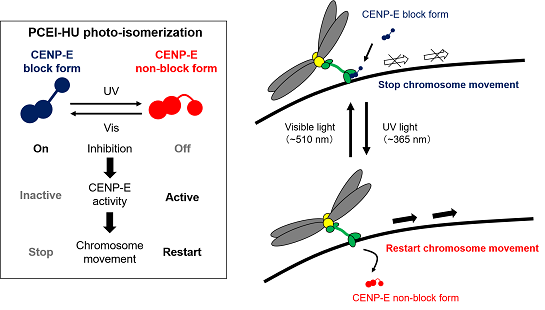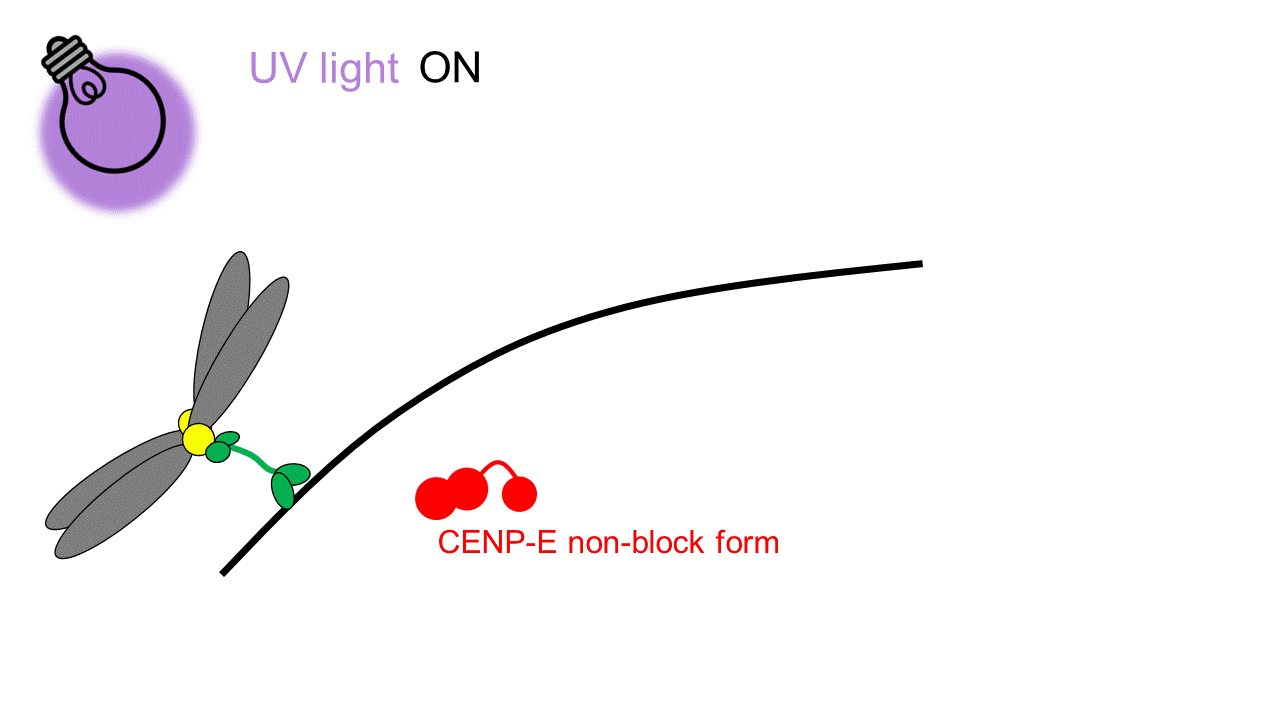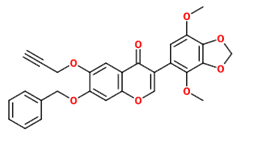HOME>
Products>
Natural and Chemical compound>
PCEI-HU | Funakoshi
HOME>
Products>
Cell Culture>
Imaging dye>
PCEI-HU | Funakoshi
Controllable by light! Chromosome Movement Regulation Reagent in Mitosis PCEI-HU | Funakoshi
Date:July 16 2020Web Page No:81511

Funakoshi Co.,Ltd.
PCEI-HU can control movements of Centromere protein E (CENP-E), a kinesin-like motor protein in metapahse of mitosis.
Visible light stops the movement of chromosome, and UV light resumes the movement of chromosome. This movement is controllable until all chromosomes are aligned on the metaphase plate in metaphase. It is a powerful tool for the fundamental investigation of prometaphase/metaphase and spindle assembly checkpoint (SAC).
※ This product has been commercialized under the license from Hokkaido University.
Product Background
Mitosis is a fundamental process of cell duplication for the growth and maintenance of tissues in multicellular
organisms. During mitosis, many kinds of proteins play crucial roles in accurate distribution of the replicated genome into two daughter cells. The replicated genomes are condensed into chromosomes in the prophase and subsequently, chromosomes move to the center of the mitotic cells, frequently called metaphase plate, along spindle microtubules in prometaphase.
Chromosomes bind to spindle microtubules via kinetochore which is a unique protein complex in centromere.
Only when all chromosomes are aligned to the metaphase plate in metaphase, separation of sister chromosome begins (anaphase).
SAC monitors accurate alignment of chromosomes in metaphase plate in mitosis to exact separation of genomic information into daughter cells. Accurate segregation of all chromosomes is the most important matter to satisfy the SAC criteria. Centromere protein E (CENP-E) is a key component for chromosome congression along microtubule spindles to the metaphase plate. CENP-E is a dimeric protein which has three domains, N-terminal motor domain, C-terminal kinetochore binding domain and coiled-coiled linker region. Recent studies suggest inhibition of ATPase activity of the CENP-E motor domain suppresses chromosome congression to the metaphase plate, subsequently SAC detects the misalignment of chromosomes and as a result, anaphase does not start.
Controlling CENP-E activity has a large potential to control mitosis progression.
Although some potent CENP-E inhibitors have been developed so far, these inhibitors are not suitable for reversibly controlling CENP-E activity.
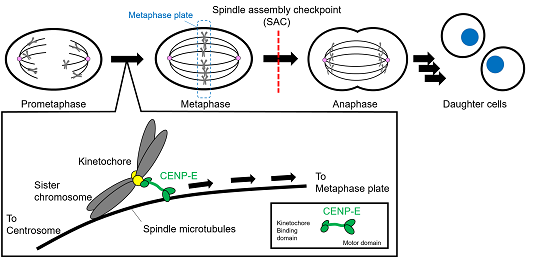
Fig.1 Overview of CENP-E in mitosis
Dr. Tamaoki, Dr. Uehara and co-workers, Hokkaido University, succeeded in obtaining the world’s first
photoswitchable CENP-E inhibitor (PCEI-HU) which contains an azobenzene-based photo-isomerization unit.
PCEI-HU can regulate CENP-E activity ON and OFF repeatedly by UV and visible light (Vis) irradiation.
PCEI-HU in water without light shows potent CENP-E inhibitory activity, but once UV light irradiation,
PCEI-HU lacks its inhibitory activity. Under the condition, CENP-E keeps its motor activity for chromosome
congression to the metaphase plate. This UV-induced loss of inhibitor action is recovered by Vis light.
After Vis irradiation, PCEI-HU blocks CENP-E activity again and chromatin congression is clearly suppressed.
PCEI-HU is a powerful tool for the fundamental investigation of prometaphase/metaphase and SAC.
Features
Data
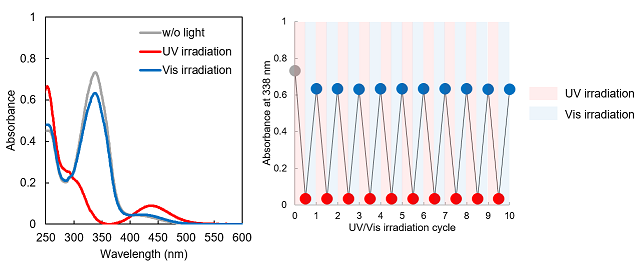
Fig.3 Absorption spectrum
Left: Absorption spectrum of PCEI-HU. Without light irradiation (w/o light; gray), after 365 nm light irradiation
(UV irradiation; red) and after 510 nm light irradiation (Vis irradiation; blue).
Right : Absorbance changes at 338 nm under alternating 365/510 nm illumination.
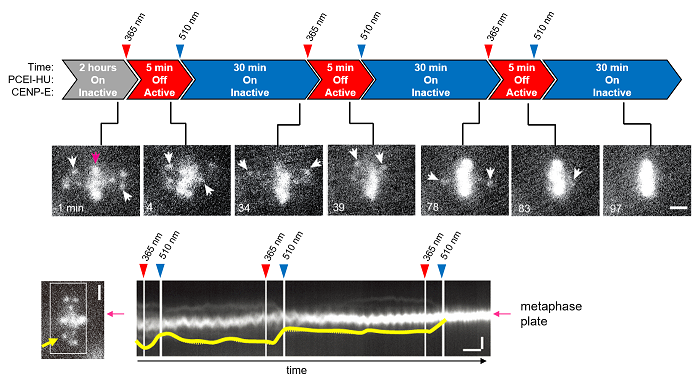
Fig.4 Live cell imaging of mitotic chromosomes in PCEI-HU treated LLC-PK 1 cells LLC-PK1 cells were treated with near-infrared DNA staining dye (SiR-DNA, 1 μM) and subsequently 1 μM PCEI-HU and 20 μM MG132 for 2 hours in darkroom. Cells were irradiated with UV light (365 nm) and Vis (510 nm) repeatedly and monitored in live-cell (Upper figure).
Movement of a specific chromosome (yellow arrow) was analyzed in kymograph (Lower figure).
While after UV irradiation, chromosomes moved to metaphase plate, but after Vis irradiation chromosomes left from metaphase plate. The chromosome was repeatedly regulated by UV/Vis cycles until chromosomes reaching to the metaphase plate.

Fig.5 Cellular localization of chromosomes, CENP-E and tubulin under photo-dependent PCEI-HU HeLa cells were treated with 1 μM PCEI-HU and 20 μM MG132*1 under following three conditions.
After these conditions, cells were fixed with PFA and visualized by specific antibodies for CENP-E and α-tubulin and DAPI staining for chromosomes.
1) Add PCEI-HU without light for 2 hours → fixation = “w/o light”
2) Add PCEI-HU without light for 2 hours → after UV irradiation, culture for 30 min = “UV irradiation”
3) Add PCEI-HU without light for 2 hours → after UV irradiation, culture for 5 min
→ after Vis irradiation, culture for 30 min = “Vis irradiation”
Under the condition 1), PCEI-HU w/o light works as the “CENP-E block form” and induced misalignment of chromosomes.
CENP-E was highly accumulated in the centrosome. Under the condition 2), UV irradiation converted PCEI-HU to “CENP-E non-block form” and all chromosomes reached to the metaphase plate. CENP-E was distributed near metaphase plate.
Under condition 3), Vis irradiation recovered CENP-E inhibitory activity of PCEI-HU and shows a similar result with 1) w/o light.
NOTE *1: MG132 is used as an anaphase inhibitor. Under MG132 treatment, mitosis did not enter anaphase even when all chromosomes were aligned in the metaphase plate.
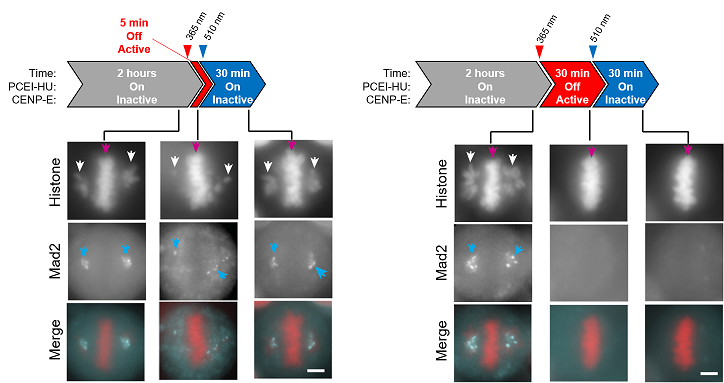
Fig.6 Functional assay to monitor a movement of Mad2, a SAC-regulatory protein HeLa cells co-expressing Mad2-GFP and histone H2B-mCherry were treated with PCEI-HU and MG132 under the following two conditions.
1) PCEI-HU w/o light for 2 hours →after UV irradiation, culture for 5 min
2) PCEI-HU w/o light for 2 hours →after UV irradiation, culture for 30 min
→after Vis irradiation, culture for 30 min →fixed and observed In both conditions, PCEI-HU w/o light-induced misalignment of chromosomes and aggregation of Mad2 in misaligned chromosomes.
In condition 1), short-term culture after UV irradiation Mad2 remained aggregated in the misaligned chromosome.
On the other hand, condition 2) showed long-term culture after UV irradiation induces correct alignment of chromosomes and Mad2 was clearly diffused in the cytosol.
These results indicate Mad2 specifically accumulated in misaligned chromosomes and after diffused in the cell by a complete alignment of chromosome in the metaphase plate.
Original Paper
Mafy, N. N., Matsuo, K., Hiruma, S., Uehara, R., and Tamaoki, N., J. Am. Chem. Soc., 142(3), 1763~1767 (2020). [PMID: 31927956]
"Photoswitchable CENP-E Inhibitor Enabling the Dynamic Control of Chromosome Movement and Mitotic Progression."
Product Information
[Date : December 27 2025 00:10]
| Detail | Product Name | Product Code | Supplier | Size | Price | ||||||||||||||||||||||||||||||
|---|---|---|---|---|---|---|---|---|---|---|---|---|---|---|---|---|---|---|---|---|---|---|---|---|---|---|---|---|---|---|---|---|---|---|---|
|
PCEI-HU, Photoswitchable CENP-E Inhibitor DatasheetThis may not be the latest data sheet. |
FDV-0037 | FNAFunakoshi Co.,Ltd. | 50 µg | $400 | |||||||||||||||||||||||||||||||
|
|
|
||||||||||||||||||||||||||||||||||
[Date : December 27 2025 00:10]
PCEI-HU, Photoswitchable CENP-E Inhibitor
DatasheetThis may not be the latest data sheet.
- Product Code: FDV-0037
- Supplier: FNA
- Size: 50µg
- Price: $400
| Description |
PCEI-HU (Photoswitchable CENP-E inhibitor) is the world's first reagent which can control movements of Centromere protein E (CENP-E), a kinesin-like motor protein in metapahse of mitosis. Visible light stops the movement of chromosome, and UV light resumes the movement of chromosome. This movement is controllable until all chromosomes are aligned on the metaphase plate in metaphase. PCEI-HU is a powerful tool for the fundamental investigation of prometaphase/metaphase and spindle assembly checkpoint (SAC). |
||
|---|---|---|---|
| Storage | -20°C | CAS | |
| Link |
|
||
Related Products
Reversible fluorescent dye for cell nucleus: NucleoSeeing™
NucleoSeeing™ is a nuclear staining reagent for live cell imaging that binds specifically to DNA and emits green fluorescence. It exhibits a high S/N values not only in animal cells and tissues, but also in Arabidopsis thaliana leaf cells, making it excellent for observing nuclear dynamics in live cells. It can also be applied for nucleus-specific pH sensing.
Long time-lapse imaging
For details, please see ☞ NucleoSeeing™(Live Nucleus Green).
gamma-tubulin specific inhibitor: Gatastatin G2
CONTACT
export@funakoshi.co.jp
- ※Prices on our website are for your reference only. Please inquire your distributor for your prices.
- ※Please note that Product Information or Price may change without notice.
